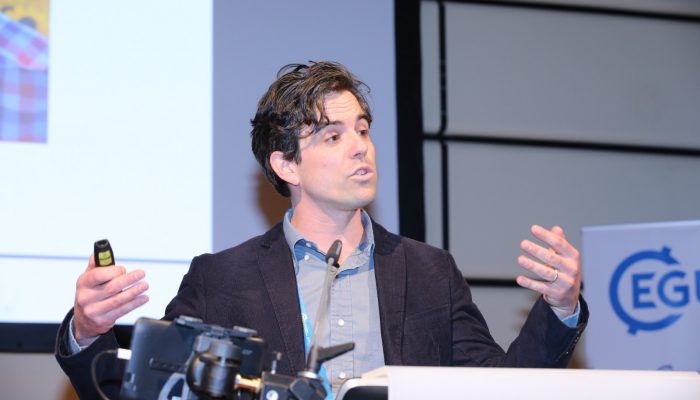
Geotalk is a regular feature highlighting early career researchers and their work. In this interview, we caught up with Christo Buizert, an assistant professor at Oregon State University in Corvallis, who works to reconstruct and understand climate change events from the past. Christo’s analysis of ice cores from Greenland and Antarctica helped reveal links between climate change events from the last ice age that occurred on opposite ends of the Earth. At this year’s General Assembly, the Climate: Past, Present & Future Division recognized his innovative contributions to palaeoclimatology by presenting him with the 2018 Division Outstanding Early Career Scientists Award.
Christo, thank you for talking to us today! Could you introduce yourself and tell us about your career path so far?
Thanks for having me on GeoTalk! I’m a palaeoclimate scientist working on polar ice cores (long sticks of ancient ice drilled in Greenland and Antarctica), combining data, modeling and fieldwork. My background is in physics, and I did a MSc thesis project on quantum electronics. As you can see, I ended up in quite a different field. After teaching high school for a year in my home country the Netherlands, I pursued a PhD at the Niels Bohr Institute in Copenhagen, Denmark, working on ice cores. I must say, doing a PhD is a lot easier than teaching high school! I have gained a lot of respect for teachers.
After obtaining my PhD I moved to the US for reasons of both work and love (not necessarily in that order). I got a NOAA Climate & Global Change Postdoctoral Fellowship at Oregon State University (OSU). OSU has a great palaeoclimate research group and Oregon is one of the prettiest places on Earth, so the decision to stick around was an easy one.
What inspired you to pursue palaeoclimatology after getting your MSc degree in quantum electronics?
I wish I had a better answer to this question, but the truth is that I was drawn by the possibility of doing fieldwork in Greenland, mainly.
At the General Assembly, you received a Division Outstanding Early Career Scientist Award for your work on understanding the bi-polar phasing of climate change. For those of us who aren’t familiar, could you elaborate on this particular field of study?
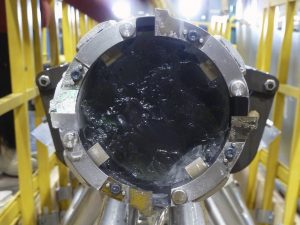
The final drill run of the WAIS Divide ice core, with ice from 3,405 m (11,171 ft) depth that has been buried for 68,000 years. (Credit: Kristina Slawny/University of Bern)
During the last ice age (120,000 to 12,000 years ago), the world experienced some of the most extreme and abrupt climate events that we know of, the so-called Dansgaard-Oeschger (D-O) events. About 25 of these D-O events happened in the ice age, and during each of them Greenland warmed by 8 to 15oC within a few decades. Each of the warm phases (called interstadials) lasted several hundreds to thousands of years. Greenland ice cores provide clear evidence for these events.
The abrupt D-O events are thought to be linked to changes in ocean circulation. Heat is transported to the Atlantic Ocean by the Atlantic Meridional Overturning Circulation (AMOC) from the southern hemisphere to the northern hemisphere. The AMOC keeps the Nordic Seas free of sea ice and effectively warms Greenland, particularly during the winter months. However, the strength of this heat circulation went through abrupt changes during the last ice age. Marine sediment data and model studies show that changes to the AMOC strength caused the extreme temperature swings associated with the D-O events.
During weak phases of the AMOC, less heat and salt are brought to the North Atlantic, leading to expansive (winter) sea ice cover and cold conditions in Greenland. These are the D-O cycle’s cold phases, the so-called stadials. And vice versa, during the AMOC’s strong phases, the ocean transports more heat northwards, reducing sea ice cover and warming Greenland. These are the warm (interstadial) phases of the D-O cycle.
When the AMOC is strong, it warms the northern hemisphere at the expense of the southern hemisphere. This inter-hemispheric heat exchange is sometimes referred to as ‘heat piracy,’ since the North Atlantic is ‘stealing’ heat from the southern hemisphere. So when Greenland is warm, we see Antarctica cool, and when Greenland is cold, Antarctica is warming. These opposite hemispheric temperature patterns are called the bipolar seesaw, after the playground toy. Using a new ice core from the West Antarctica Ice Sheet (the WAIS Divide ice core), we were able to study the relative timing of the bipolar seesaw at a precision of a few decades – which is extremely precise by the standards of palaeoclimate research.
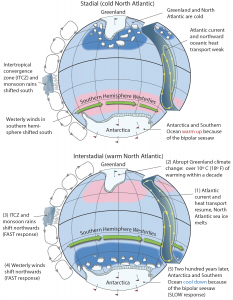
An infographic explaining the opposite hemispheric temperature patterns, also known as the bipolar seesaw (Illustration by David Reinert/Oregon State University).
We found that the temperature response to the northern hemisphere’s abrupt D-O events was delayed by about two centuries at WAIS Divide. This finding shows that the effects of these D-O events start in the north, and then are transmitted to the southern high-latitudes via changes in the ocean circulation. If the atmosphere were responsible, transmission would have been much faster (typically within a year or so). State-of-the-art climate models actually fail to simulate this 200-year delay in the Antarctic response, suggesting they are missing (or overly simplifying) some of the relevant physics of how temperature anomalies are propagated and mixed in the global ocean. The timescale of two centuries is unmistakably the signature of the ocean, in my view, and so it is an interesting target for testing models.
At the meeting you also gave a talk about the climatic connections between the northern and southern hemispheres during the last ice age. Could you tell us a little more about your findings and their implications?
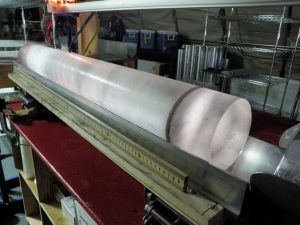
A volcanic ash layer in an Antarctic ice core. Volcanic markers like these were used in the new study to synchronize ice cores from across Antarctica. (Credit: Heidi Roop/Oregon State University)
I presented some recently published work that elaborates on this 200-year delay mentioned earlier. Together with European colleagues, we synchronized five Antarctic ice cores using volcanic eruptions as time markers. This makes it possible to study the timing of the seesaw across the entire Antarctic continent with the same great precision as at WAIS Divide. It turns out that the 200-year delayed oceanic response to the northern hemisphere’s abrupt climate change is visible all over Antarctica, not just in West Antarctica.
But the exciting thing is that by looking at the spatial picture, we detect a second mode of climatic teleconnection, superimposed on the bipolar seesaw we talked about earlier. This second mode has zero-time lag behind the northern hemisphere, suggesting that this mode is an atmospheric teleconnection pattern. In my talk I used postcards and text messages as an analogy for these two modes. The oceanic mode is like a postcard, that takes a long time to arrive in Antarctica (200 years). The atmospheric mode is like a text message that arrives right away.
The atmospheric circulation change (the “text message”) causes a particular temperature pattern over Antarctica, with cooling in some places and warming in others. Think of this as the “fingerprint” of the atmospheric circulation. We then compared the ice-core fingerprint to the fingerprints of several wind patterns seen in modern observations. We found that the so-called Southern Annular Mode, a natural mode describing the variability of the westerly winds circling Antarctica, is the best modern analog for what we see in the ice cores.
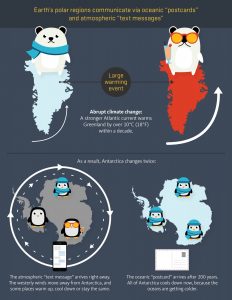
An infographic explaining how Earth’s polar regions communicate with each other (Illustration by Oliver Day/Oregon State University)
Another piece of the puzzle is that atmospheric moisture pathways to Antarctica change simultaneously with the atmospheric mode. All this supports the idea that the southern hemisphere’s westerly winds respond immediately to abrupt climate change in the North Atlantic. When D-O warming happens in Greenland the SH westerlies shift to the north, and vice versa, during D-O cooling they shift to the south.
This had been predicted in models, and some limited evidence was available from the WAIS Divide ice core, but the new results provide the strongest observational evidence for this effect. This movement of the westerlies has important consequences for sea ice, ocean circulation, and perhaps even CO2 levels and ice sheet stability. So it really urges us to look at these D-O cycle in a global perspective.
You’ve enjoyed success as a researcher, not least your 2018 EGU Award. As an early career scientist, do you have any words of advice for graduate students who are hoping to pursue a career as a scientist in the Earth sciences?
I’m sure there are many different routes to becoming a successful researcher. Developing your own ideas and insights is key, and the secret to having good ideas is having many ideas, because most of them end up being wrong! So be creative and go out on a limb. I am lucky to have had supervisors who gave me a lot of freedom to explore my own ideas. I would also encourage everybody to develop skills in programming and numerical data analysis, for example in Matlab or python.
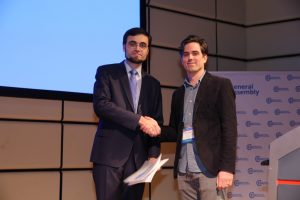
Christo Buizert (right) and Didier Roche, President of the Climate: Past, Present & Future Division, (left) at the EGU 2018 General Assembly (Credit: EGU/Foto Pflugel).
Frustrating and unfair as it may be, luck plays an important role in getting your research career started. My main PhD project did not work out, but I had a very productive postdoc that grew out of a side project. I ended up in the right place at the right time, because the WAIS Divide ice core had just been drilled, and I got the privilege to work with some of the best ice core data ever measured.
Research is fundamentally a collaborative enterprise, and so developing a good network of collaborators is maybe the most important thing you can do for yourself. Be generous and helpful to your colleagues, and it will be rewarded.
A career in science sometimes feels like a game of musical chairs, with fewer and fewer positions available as you go along. But if you can hang in there it’s definitely worth it; we have the privilege of thinking about interesting problems, traveling to beautiful places, all while interacting with a global network of fantastic colleagues. Could it get much better?
Interview by Olivia Trani, EGU Communications Officer


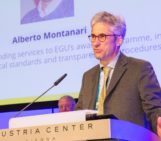


Professor Prem raj Pushpakaran
Professor Prem raj Pushpakaran writes — 2022 marks the birth centenary year of Nikolay Gennadiyevich Basov!!!
https://www.youth4work.com/y/profpremrajpushpakaran/Prof-Prem-Raj-Pushpakaran-popularity